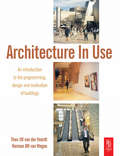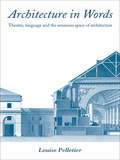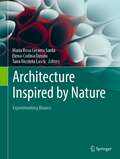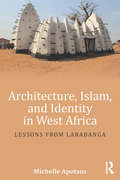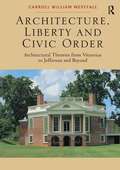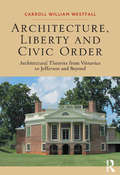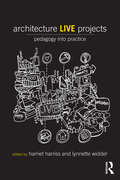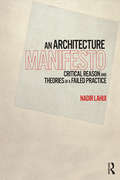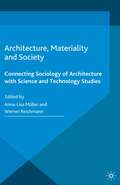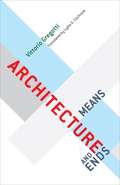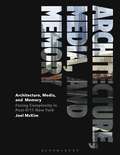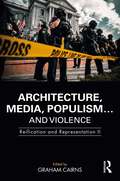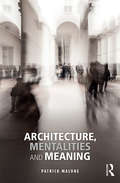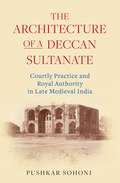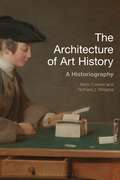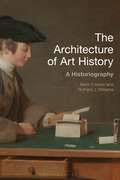- Table View
- List View
Architecture In Use
by DJM van der Voordt HBR van WegenThis unique book discusses programming, design and building evaluation providing a ‘joined up’ approach to building design. By linking the functional and architectonic qualities of a building, the authors show the practical implications of the utility value of buildings. Starting by looking at how the relationship between form and function has been dealt with by different approaches to architecture from a historical perspective, it goes on to discuss how the desired functional quality and utility value of a building can be expressed in a brief and given a physical form by the architect. Finally, it advises on how to carry out post-occupancy evaluation and provides the architect with methods and techniques for testing whether the intended utility value of a building has been achieved.
Architecture in Words: Theatre, Language and the Sensuous Space of Architecture
by Louise PelletierWhat if the house you are about to enter was built with the confessed purpose of seducing you, of creating various sensations destined to touch your soul and make you reflect on who you are? Could architecture have such power? This was the assumption of generations of architects at the beginning of modernity. Exploring the role of theatre and fiction in defining character in architecture, Louise Pelletier examines how architecture developed to express political and social intent. Applying this to the modern day, Pelletier considers how architects can learn from these eighteenth century attitudes in order to restore architecture's communicative dimension. Through an in-depth and interdisciplinary analysis of the beginning of modernity, Louise Pelletier encourages today's architects to consider the political and linguistic implications of their tools. Combining theory, historical studies and research, Architecture in Words will provoke thought and enrich the work of any architect.
Architecture in Words: Theatre, Language and the Sensuous Space of Architecture
by Louise PelletierWhat if the house you are about to enter was built with the confessed purpose of seducing you, of creating various sensations destined to touch your soul and make you reflect on who you are? Could architecture have such power? This was the assumption of generations of architects at the beginning of modernity. Exploring the role of theatre and fiction in defining character in architecture, Louise Pelletier examines how architecture developed to express political and social intent. Applying this to the modern day, Pelletier considers how architects can learn from these eighteenth century attitudes in order to restore architecture's communicative dimension. Through an in-depth and interdisciplinary analysis of the beginning of modernity, Louise Pelletier encourages today's architects to consider the political and linguistic implications of their tools. Combining theory, historical studies and research, Architecture in Words will provoke thought and enrich the work of any architect.
Architecture Inspired by Nature: Experimenting Bionics
by María Rosa Cervera Sardá Elena-Codina Dușoiu Tana Nicoleta LascuThe book brings together the research completed during 10 editions of International Seminars of Bionics, organized by the School of Architecture of the University of Alcalá de Henares, Madrid, several of them in partnership with the “Ion Mincu” University of Architecture and Urbanism, Bucharest, carried out in Spain and in Romania. The articles here consider advanced bionic design principles, implementing them to an impressive variety of application fields, including, but not limited to, urban planning and landscape, public space, architecture and building structures, design and detailing, application of natural dynamic processes, bio-digital architecture, innovative materials based on living organisms (micro-algae), and nano-modified materials. A particular focus is given to light and perception of light. To illustrate the principles developed, this contributed volume includes descriptions and full-color images of the experimental projects created during the workshops held in the framework of these ISB meetings: Learning from Nature, Integrating Bionics (2009); Adaptability, Efficiency and Biostructures (2010); Bionics and Innovation (2011); Forms and Structures Inspired by Nature (2016, 2017); Furniture Inspired by Natural Models (2018); Relation between Structure and Envelope: Light Structures (2019); Light, from Nature to Architecture. Structures Inspired in Nature (2020); Light in Architecture and Design: A Bionic Perspective (2021); Sustainable Thinking and Bionics (2022).
Architecture, Islam, and Identity in West Africa: Lessons from Larabanga
by Michelle ApotsosArchitecture, Islam, and Identity in West Africa shows you the relationship between architecture and Islamic identity in West Africa. The book looks broadly across Muslim West Africa and takes an in-depth study of the village of Larabanga, a small Muslim community in Northern Ghana, to help you see how the built environment encodes cultural history through form, material, and space, creating an architectural narrative that outlines the contours of this distinctive Muslim identity. Apotsos explores how modern technology, heritage, and tourism have increasingly affected the contemporary architectural character of this community, revealing the village’s current state of social, cultural, and spiritual flux. More than 60 black and white images illustrate how architectural components within this setting express the distinctive narratives, value systems, and realities that make up the unique composition of this Afro-Islamic community.
Architecture, Islam, and Identity in West Africa: Lessons from Larabanga
by Michelle ApotsosArchitecture, Islam, and Identity in West Africa shows you the relationship between architecture and Islamic identity in West Africa. The book looks broadly across Muslim West Africa and takes an in-depth study of the village of Larabanga, a small Muslim community in Northern Ghana, to help you see how the built environment encodes cultural history through form, material, and space, creating an architectural narrative that outlines the contours of this distinctive Muslim identity. Apotsos explores how modern technology, heritage, and tourism have increasingly affected the contemporary architectural character of this community, revealing the village’s current state of social, cultural, and spiritual flux. More than 60 black and white images illustrate how architectural components within this setting express the distinctive narratives, value systems, and realities that make up the unique composition of this Afro-Islamic community.
Architecture, Liberty and Civic Order: Architectural Theories from Vitruvius to Jefferson and Beyond (PDF)
by Carroll William WestfallThis book brings to light central topics that are neglected in current histories and theories of architecture and urbanism. These include the role of imitation in earlier centuries and its potential role in present practice; the necessary relationship between architecture, urbanism and the rural districts; and their counterpart in the civil order that builds and uses what is built. The narrative traces two models for the practice of architecture. One follows the ancient model in which the architect renders his service to serve the interests of others; it survives and is dominant in modernism. The other, first formulated in the fifteenth century by Leon Battista Alberti, has the architect use his talent in coordination with others to contribute to the common good of a republican civil order that seeks to protect its own liberty and that of its citizens. Palladio practiced this way, and so did Thomas Jefferson when he founded a uniquely American architecture, the counterpart to the nation’s founding. This narrative gives particular emphasis to the contrasting developments in architecture on the opposite sides of the English Channel. The book presents the value for clients and architects today and in the future of drawing on history and tradition. It stresses the importance, indeed, the urgency, of restoring traditional practices so that we can build just, beautiful, and sustainable cities and rural districts that will once again assist citizens in living not only abundantly but also well as they pursue their happiness.
Architecture, Liberty and Civic Order: Architectural Theories from Vitruvius to Jefferson and Beyond
by Carroll William WestfallThis book brings to light central topics that are neglected in current histories and theories of architecture and urbanism. These include the role of imitation in earlier centuries and its potential role in present practice; the necessary relationship between architecture, urbanism and the rural districts; and their counterpart in the civil order that builds and uses what is built. The narrative traces two models for the practice of architecture. One follows the ancient model in which the architect renders his service to serve the interests of others; it survives and is dominant in modernism. The other, first formulated in the fifteenth century by Leon Battista Alberti, has the architect use his talent in coordination with others to contribute to the common good of a republican civil order that seeks to protect its own liberty and that of its citizens. Palladio practiced this way, and so did Thomas Jefferson when he founded a uniquely American architecture, the counterpart to the nation’s founding. This narrative gives particular emphasis to the contrasting developments in architecture on the opposite sides of the English Channel. The book presents the value for clients and architects today and in the future of drawing on history and tradition. It stresses the importance, indeed, the urgency, of restoring traditional practices so that we can build just, beautiful, and sustainable cities and rural districts that will once again assist citizens in living not only abundantly but also well as they pursue their happiness.
Architecture, Liberty and Civic Order: Architectural Theories from Vitruvius to Jefferson and Beyond
by Carroll William WestfallThis book brings to light central topics that are neglected in current histories and theories of architecture and urbanism. These include the role of imitation in earlier centuries and its potential role in present practice; the necessary relationship between architecture, urbanism and the rural districts; and their counterpart in the civil order that builds and uses what is built. The narrative traces two models for the practice of architecture. One follows the ancient model in which the architect renders his service to serve the interests of others; it survives and is dominant in modernism. The other, first formulated in the fifteenth century by Leon Battista Alberti, has the architect use his talent in coordination with others to contribute to the common good of a republican civil order that seeks to protect its own liberty and that of its citizens. Palladio practiced this way, and so did Thomas Jefferson when he founded a uniquely American architecture, the counterpart to the nation’s founding. This narrative gives particular emphasis to the contrasting developments in architecture on the opposite sides of the English Channel. The book presents the value for clients and architects today and in the future of drawing on history and tradition. It stresses the importance, indeed, the urgency, of restoring traditional practices so that we can build just, beautiful, and sustainable cities and rural districts that will once again assist citizens in living not only abundantly but also well as they pursue their happiness.
Architecture, Liberty and Civic Order: Architectural Theories from Vitruvius to Jefferson and Beyond
by Carroll William WestfallThis book brings to light central topics that are neglected in current histories and theories of architecture and urbanism. These include the role of imitation in earlier centuries and its potential role in present practice; the necessary relationship between architecture, urbanism and the rural districts; and their counterpart in the civil order that builds and uses what is built. The narrative traces two models for the practice of architecture. One follows the ancient model in which the architect renders his service to serve the interests of others; it survives and is dominant in modernism. The other, first formulated in the fifteenth century by Leon Battista Alberti, has the architect use his talent in coordination with others to contribute to the common good of a republican civil order that seeks to protect its own liberty and that of its citizens. Palladio practiced this way, and so did Thomas Jefferson when he founded a uniquely American architecture, the counterpart to the nation’s founding. This narrative gives particular emphasis to the contrasting developments in architecture on the opposite sides of the English Channel. The book presents the value for clients and architects today and in the future of drawing on history and tradition. It stresses the importance, indeed, the urgency, of restoring traditional practices so that we can build just, beautiful, and sustainable cities and rural districts that will once again assist citizens in living not only abundantly but also well as they pursue their happiness.
Architecture Live Projects: Pedagogy into Practice
by Harriet Harriss Lynnette WidderArchitecture Live Projects provides a persuasive, evidence-based advocacy for moving a particular kind of architectural learning, known as Live Projects, towards a holistic integration into current and future architectural curricula. Live Projects are work completed in the borderlands between architectural education and built environment practice; they include design/build work, community-based design, urban advocacy consulting and a host of other forms and models described by the book’s international group of authors. Because of their position, Live Projects as vehicle for simultaneously providing teaching and service has the potential to recalibrate the contesting claims that both academia and profession make to architecture. This collection of essays and case studies consolidates current discussions on theory and learning ambitions, academic best practices, negotiation with licensure and accreditation, and considerations of architectural integrity. It is an invaluable resource to current and future Live Projects advocates – whether they aim to move from pedagogy into practice or practice into pedagogy.
Architecture Live Projects: Pedagogy into Practice
by Harriet Harriss Lynnette WidderArchitecture Live Projects provides a persuasive, evidence-based advocacy for moving a particular kind of architectural learning, known as Live Projects, towards a holistic integration into current and future architectural curricula. Live Projects are work completed in the borderlands between architectural education and built environment practice; they include design/build work, community-based design, urban advocacy consulting and a host of other forms and models described by the book’s international group of authors. Because of their position, Live Projects as vehicle for simultaneously providing teaching and service has the potential to recalibrate the contesting claims that both academia and profession make to architecture. This collection of essays and case studies consolidates current discussions on theory and learning ambitions, academic best practices, negotiation with licensure and accreditation, and considerations of architectural integrity. It is an invaluable resource to current and future Live Projects advocates – whether they aim to move from pedagogy into practice or practice into pedagogy.
An Architecture Manifesto: Critical Reason and Theories of a Failed Practice
by Nadir LahijiWhat is a manifesto? In basic terms, a manifesto is ‘the invention of future for the present’. We have been oblivious to the fact that the twentieth century was the century of manifestos. It was the century of programmatic declarations, radical and avant-garde political, artistic and architectural proclamations. Manifestos came to be a genre of concise and radical-critical writings exposing the repressed contradictions in a dominant doctrine. They opened up the present to the future by denouncing the forces of the status quo and offering alternative programs. Today, this genre is a more valid, even urgent, form of writing for our time, in order to expose the dominant doctrine that has closed the future in subscribing to the ideology of the ‘end of history’. In this manifesto, Nadir Lahiji takes a leap of faith. It is a faith in Lost Causes. He asserts that today, architectonic reason has fallen into ruins. As soon as architecture leaves the limits set to it by architectonic reason, no other path is open to it but the path to aestheticism. This is the wrong path contemporary architecture has taken. In its reduction to a pure aesthetic object, architecture negatively affects the human sensorium. Capitalist consumer society creates desires by generating ‘surplus-enjoyment’ for capitalist profit and contemporary architecture has become an instrument in generating this ‘surplus-enjoyment’, with fatal consequences. This manifesto is thus both a critique and a work of theory. It is a siren, alarm, klaxon to the current status quo within architectural discourse and a timely response to the conditions of architecture today.
An Architecture Manifesto: Critical Reason and Theories of a Failed Practice
by Nadir LahijiWhat is a manifesto? In basic terms, a manifesto is ‘the invention of future for the present’. We have been oblivious to the fact that the twentieth century was the century of manifestos. It was the century of programmatic declarations, radical and avant-garde political, artistic and architectural proclamations. Manifestos came to be a genre of concise and radical-critical writings exposing the repressed contradictions in a dominant doctrine. They opened up the present to the future by denouncing the forces of the status quo and offering alternative programs. Today, this genre is a more valid, even urgent, form of writing for our time, in order to expose the dominant doctrine that has closed the future in subscribing to the ideology of the ‘end of history’. In this manifesto, Nadir Lahiji takes a leap of faith. It is a faith in Lost Causes. He asserts that today, architectonic reason has fallen into ruins. As soon as architecture leaves the limits set to it by architectonic reason, no other path is open to it but the path to aestheticism. This is the wrong path contemporary architecture has taken. In its reduction to a pure aesthetic object, architecture negatively affects the human sensorium. Capitalist consumer society creates desires by generating ‘surplus-enjoyment’ for capitalist profit and contemporary architecture has become an instrument in generating this ‘surplus-enjoyment’, with fatal consequences. This manifesto is thus both a critique and a work of theory. It is a siren, alarm, klaxon to the current status quo within architectural discourse and a timely response to the conditions of architecture today.
Architecture, Materiality and Society: Connecting Sociology of Architecture with Science and Technology Studies
by Anna-Lisa Müller Werner ReichmannThis book examines the extent to which the insights of STS can be used to analyse the role of architecture in and for social life. The contributions examine the question of whether architecture and thus materiality as a whole has agency. The book also proposes a theoretical and methodological approach on how to research architecture's agency.
Architecture, Means and Ends
by Vittorio GregottiVittorio Gregotti—the architect of Barcelona’s Olympic Stadium, Milan’s Arcimboldi Opera Theater, and Lisbon’s Centro Cultural de Belém, among many other noted constructions—is not only a designer of international repute but an acclaimed theorist and critic. Architecture, Means and Ends is his practical and imaginative reflection on the role of the technical aspects of architectural design, both as part of the larger process of innovation and in relation to the mythic opposition between vision and construction. Interweaving the seemingly irreconcilable concerns of aesthetics, meaning, and construction, Architecture, Means and Ends reflects Gregotti’s overarching claim that buildings always have a symbolic, cultural content. In this book, he argues that by making symbolic expression a primary objective in the design of a project, the designer will produce a practical aesthetic as well as an ethical solution. Architecture, Means and Ends embraces that philosophy and will appeal to those, like Gregotti, working at the intersections of the history of design, art criticism, and architectural theory.
Architecture, Media, and Memory: Facing Complexity in Post-9/11 New York
by Joel McKimArchitecture, Media and Memory examines the wide range of urban sites impacted by September 11 and its aftermath – from the spontaneous memorials that emerged in Union Square in the hours after the attacks, to the reconstruction at Ground Zero, to vast ongoing landscape urbanism projects beyond.Yet this is not simply a book about post-9/11 architecture. It instead presents 9/11 as a multifaceted case study to explore a discourse on memory and its representation in the built environment. It argues that the reconstruction of New York must be considered in relation to larger issues of urban development, ongoing global conflicts, the rise of digital media, and the culture, philosophy and aesthetics of memory. It shows how understanding architecture in New York post-9/11 requires bringing memory into contact with a complex array of political, economic and social forces.Demonstrating an ability to explain complex philosophical ideas in language that will be accessible to students and researchers alike in architecture, urban studies, cultural studies and memory studies, this book serves as a thought-provoking account of the intertwining of contemporary architecture, media and memory.
Architecture, Media, and Memory: Facing Complexity in Post-9/11 New York
by Joel McKimArchitecture, Media and Memory examines the wide range of urban sites impacted by September 11 and its aftermath – from the spontaneous memorials that emerged in Union Square in the hours after the attacks, to the reconstruction at Ground Zero, to vast ongoing landscape urbanism projects beyond.Yet this is not simply a book about post-9/11 architecture. It instead presents 9/11 as a multifaceted case study to explore a discourse on memory and its representation in the built environment. It argues that the reconstruction of New York must be considered in relation to larger issues of urban development, ongoing global conflicts, the rise of digital media, and the culture, philosophy and aesthetics of memory. It shows how understanding architecture in New York post-9/11 requires bringing memory into contact with a complex array of political, economic and social forces.Demonstrating an ability to explain complex philosophical ideas in language that will be accessible to students and researchers alike in architecture, urban studies, cultural studies and memory studies, this book serves as a thought-provoking account of the intertwining of contemporary architecture, media and memory.
Architecture, Media, Populism… and Violence: Reification and Representation II
by Graham CairnsThe ‘Storming of the Capitol’ was, for many, the culminating media performance of the four-year presidency of Donald Trump. His presidency and its ‘final act’, bore all the hallmarks of a 21st century form of populism and media-politico spectacle that may yet come to dominate the political scene in the US, and worldwide, for years to come. The questions that such events raise are complex, varied and operative across a multitude of disciplines. This book engages with these vexed questions in the broad fields of politics and media, but does so, uniquely, through the prism of architecture. This book does not, however, limit its view to the recent events in Washington DC or the United States. Rather, it seeks to use those events as the starting point for a critique of architecture in the tapestry of mediated forms of protest and ‘political action’ more generally. Each chapter draws on case studies from across timeframes and across nations. The book sharpens our critique of the relationship between direct political action, its media representation and the role it assigns to architecture – as played out globally in the age of mass media. In doing so, it opens up broader debates about the past, present and future roles of architecture as a political tool in the context of international political systems now dominated by changing and unpredictable uses of media, and characterised by an increasingly volatile and at times violent form of political activism. It is essential reading for any student or researcher engaging with these questions.
Architecture, Media, Populism… and Violence: Reification and Representation II
by Graham CairnsThe ‘Storming of the Capitol’ was, for many, the culminating media performance of the four-year presidency of Donald Trump. His presidency and its ‘final act’, bore all the hallmarks of a 21st century form of populism and media-politico spectacle that may yet come to dominate the political scene in the US, and worldwide, for years to come. The questions that such events raise are complex, varied and operative across a multitude of disciplines. This book engages with these vexed questions in the broad fields of politics and media, but does so, uniquely, through the prism of architecture. This book does not, however, limit its view to the recent events in Washington DC or the United States. Rather, it seeks to use those events as the starting point for a critique of architecture in the tapestry of mediated forms of protest and ‘political action’ more generally. Each chapter draws on case studies from across timeframes and across nations. The book sharpens our critique of the relationship between direct political action, its media representation and the role it assigns to architecture – as played out globally in the age of mass media. In doing so, it opens up broader debates about the past, present and future roles of architecture as a political tool in the context of international political systems now dominated by changing and unpredictable uses of media, and characterised by an increasingly volatile and at times violent form of political activism. It is essential reading for any student or researcher engaging with these questions.
Architecture, Mentalities and Meaning
by Patrick MaloneIn order to function, architectural theory and practice must be shaped to suit current cultural, economic, and political forces. Thus, architecture embodies reductive logic that conditions the treatment of human and social processes – which raises the question of how to define objectivity for architectural mentalities that must conform to a set of immediate conditions. This book focuses on meaning, and on the physical and mental processes that define life in built environments. The potential to draw knowledge from aesthetics, psychology, political economy, philosophy, geography, and sociology is offset by the fact that architectural logic is inevitably reductive, cultural, socio-economic, and political. However, despite the duty to conform, it is argued that the treatment of human processes, and the understanding of architectural mentalities, can benefit from interdisciplinary linkages, small freedoms, and cracks in a system of imperatives that can yield the means of greater objectivity. This is valuable reading for students and researchers interested in architectural theory as a working reality, and in the relationships between architecture and other fields.
Architecture, Mentalities and Meaning
by Patrick MaloneIn order to function, architectural theory and practice must be shaped to suit current cultural, economic, and political forces. Thus, architecture embodies reductive logic that conditions the treatment of human and social processes – which raises the question of how to define objectivity for architectural mentalities that must conform to a set of immediate conditions. This book focuses on meaning, and on the physical and mental processes that define life in built environments. The potential to draw knowledge from aesthetics, psychology, political economy, philosophy, geography, and sociology is offset by the fact that architectural logic is inevitably reductive, cultural, socio-economic, and political. However, despite the duty to conform, it is argued that the treatment of human processes, and the understanding of architectural mentalities, can benefit from interdisciplinary linkages, small freedoms, and cracks in a system of imperatives that can yield the means of greater objectivity. This is valuable reading for students and researchers interested in architectural theory as a working reality, and in the relationships between architecture and other fields.
The Architecture of a Deccan Sultanate: Courtly Practice and Royal Authority in Late Medieval India (Library Of Islamic South Asia Ser.)
by Pushkar SohoniThe Deccan sultans left a grand architectural and artistic legacy. They commissioned palaces, mosques, gardens and tombs as well as decorative paintings and coins. Of these sultanates, the Nizam Shahs (r. 1490-1636) were particularly significant, being one of the first to emerge from the crumbling edifice of the Bahmani Empire (c. 1347-1527). Yet their rich material record remains largely unstudied in the scholarly literature, obscuring their cultural and historical importance. This book provides the first analysis of the architecture of the Nizam Shahs. Pushkar Sohoni examines the critical relationship between architectural production, courtly practice and royal authority in a period when the aspirations and politics of the kingdom were articulated through architectural expression. Based on new primary research from key sites including the urban settlements of Ahmadnagar, Daulatabad, Aurangabad, Junnar and the port city of Chaul, Sohoni sheds light on broader Islamicate ideas of kingship and shows how this was embodied by material artefacts such as buildings and sites, paintings, gardens, guns and coins.As well as offering a vivid depiction of sixteenth-century South Asia, this book revises understanding of the cultural importance of the Nizam Shahs and their place in the Indian Ocean world. It will be a vital primary resource for scholars researching the history of the medieval and early modern Deccan and relevant for those working in Art History, Islamic Studies, South Asian Studies and Archaeology.
The Architecture of Art History: A Historiography (History of Art and Architecture)
by Mark Crinson Richard J. WilliamsWhat is the place of architecture in the history of art? Why has it been at times central to the discipline, and at other times seemingly so marginal? What is its place now? Many disciplines have a stake in the history of architecture – sociology, anthropology, human geography, to name a few. This book deals with perhaps the most influential tradition of all – art history – examining how the relation between the disciplines of art history and architectural history has waxed and waned over the last one hundred and fifty years. In this highly original study, Mark Crinson and Richard J. Williams point to a decline in the importance attributed to the role of architecture in art history over the last century – which has happened without crisis or self-reflection. The book explores the problem in relation to key art historical approaches, from formalism, to feminism, to the social history of art, and in key institutions from the Museum of Modern Art, to the journal October. Among the key thinkers explored are Banham, Baxandall, Giedion, Panofsky, Pevsner, Pollock, Riegl, Rowe, Steinberg, Wittkower and Wölfflin. The book will provoke debate on the historiography and present state of the discipline of art history, and it makes a powerful case for the reconsideration of architecture.
The Architecture of Art History: A Historiography (History of Art and Architecture)
by Mark Crinson Richard J. WilliamsWhat is the place of architecture in the history of art? Why has it been at times central to the discipline, and at other times seemingly so marginal? What is its place now? Many disciplines have a stake in the history of architecture – sociology, anthropology, human geography, to name a few. This book deals with perhaps the most influential tradition of all – art history – examining how the relation between the disciplines of art history and architectural history has waxed and waned over the last one hundred and fifty years. In this highly original study, Mark Crinson and Richard J. Williams point to a decline in the importance attributed to the role of architecture in art history over the last century – which has happened without crisis or self-reflection. The book explores the problem in relation to key art historical approaches, from formalism, to feminism, to the social history of art, and in key institutions from the Museum of Modern Art, to the journal October. Among the key thinkers explored are Banham, Baxandall, Giedion, Panofsky, Pevsner, Pollock, Riegl, Rowe, Steinberg, Wittkower and Wölfflin. The book will provoke debate on the historiography and present state of the discipline of art history, and it makes a powerful case for the reconsideration of architecture.
